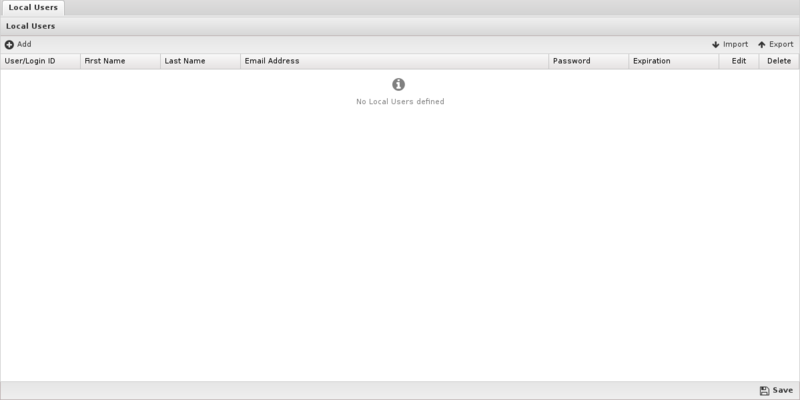Local Users: Difference between revisions
No edit summary |
|||
| Line 8: | Line 8: | ||
{{BiScreenshot|config|local-directory}} | {{BiScreenshot|config|local-directory}} | ||
To add new users click on the Add button. You must supply a username, first name, last name, email address, and password. Only the | To add new users click on the Add button. You must supply a username, first name, last name, email address, and password. Only the administrator can set the password for a given user. Users can be imported or exported using the import/export buttons on the upper right. | ||
An expiration date can be specified for a user. If the expiration date has passed that user will no longer be authenticated. | An expiration date can be specified for a user. If the expiration date has passed that user will no longer be authenticated. | ||
Revision as of 03:30, 14 May 2019
Local Users
Local Users stores a list of users that can be used by the applications. For example, Captive Portal can use the local directory to authenticate users.

To add new users click on the Add button. You must supply a username, first name, last name, email address, and password. Only the administrator can set the password for a given user. Users can be imported or exported using the import/export buttons on the upper right.
An expiration date can be specified for a user. If the expiration date has passed that user will no longer be authenticated.
To use the Local Directory, simply configure Captive Portal to authenticate against the Local Directory while requiring user authentication.
WARNING: Typically, when passwords are stored, password hashes are saved and the original cleartext password is forgotten so administrators do not have access to user passwords. However, The passwords for users are stored in the local directory are stored in cleartext because some applications and features (L2TP) depend on access to the cleartext password. Administrators do have access to cleartext user passwords and caution is advised.
